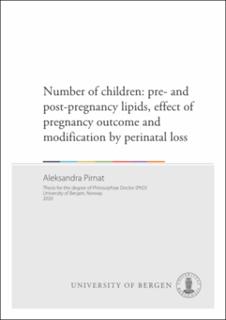Number of children: pre- and post-pregnancy lipids, effect of pregnancy outcome and modification by perinatal loss
Doctoral thesis
Permanent lenke
https://hdl.handle.net/1956/21391Utgivelsesdato
2020-01-07Metadata
Vis full innførselSamlinger
Sammendrag
Background: Cardiovascular disease (CVD) is an important public health problem and remains the number one cause of death in women. Substantial increase in CVD mortality has been found in women with only one child, and lipid disorders are suggested to play a role in both subfertility and later CVD development. Objectives: To explore the extent to which pre-pregnant serum lipid levels of total, low density lipoprotein (LDL) and high density lipoprotein (HDL) cholesterol, triglyceride (TG) and triglycerides to high density lipoprotein (TG/HDL) ratio are associated with having no and one lifetime pregnancy; to estimate post-pregnancy lipid levels in one-child mothers compared to mothers with two or more children and to assess these lipid’s associations with number of children; to explore if preterm delivery (PTD), preeclampsia (PE), small for gestational age (SGA) and cesarean section (CS) at first birth are associated with having one lifetime pregnancy, and assess the modifying effect of perinatal loss. Material and Methods: In paper I we analysed prepregnant lipid levels in 2 645 women giving birth to their first child during 1994 - 2003 and in 1 677 nulliparous women with linked data from Cohort of Norway (CONOR) and The Medical Birth Registry of Norway (MBRN). In paper II we used data on 32 618 parous women examined after first childbirth as part of CONOR (1994-2003) with linked data on reproduction and number of children from the MBRN (1967-2008). Paper III was a population-based study of 882 803 mothers giving birth to their first singleton infant (≥22 gestational weeks) during 1967 to 2007 who were followed for the occurrence of second birth in the MBRN until 2014. Logistic regression (Papers I and II) and generalized linear models (Paper III) were used to calculate odds ratios (ORs) and relative risks (RRs) with 95% confidence intervals (CIs) and to adjust for confounders. Results: Assessed in quintiles, higher pre-pregnant TG and TG/HDL ratio levels were associated with increased risk of one lifetime pregnancy compared to having ≥ 2 children. Compared to the highest quintile, women in the lowest quintile of HDL cholesterol levels had an increased risk of one lifetime pregnancy (OR 1.7 95% CI 1.2-2.4), as were women with the highest LDL cholesterol, TG and TG/HDL ratio quintiles (compared to the lowest) (OR 1.2 95% CI 0.8-1.7; OR 2.2 95% CI 1.5-3.2; and OR 2.2 95% CI 1.5-3.2, respectively). X Similar effects were found in women with BMI ≥ 25 and the highest LDL and total cholesterol levels in risk of lifetime nulliparity. When examined after first childbirth in paper II, ORs for one lifetime pregnancy for the highest quintiles of LDL and total cholesterol (compared to lowest quintiles) were 1.30 (95%CI: 1.14-1.45) and 1.43 (95%CI: 1.27-1.61), respectively. In women with pregnancy complications where the infant survived the perinatal period, RRs for one lifetime pregnancy were increased (PTD: 1.21 [1.19-1.22], SGA: 1.13 [1.12-1.15], PE: 1.09 [1.07-1.11], CS: 1.24 [1.23-1.25]), but significantly reduced if the child was lost (PTD: 0.63 [0.59-0.68], SGA: 0.57 [0.51-0.63], PE: 0.69 [0.59-0.80], CS: 0.67 [0.56-0.79]), compared to women with no perinatal loss and no adverse outcome. Conclusions and implications: Unfavorable pre-pregnant lipid levels were associated with having no and one lifetime pregnancy. The association with unfavourable lipids was also present for one child mothers with lipids measured more than a decade after childbirth. These findings provide a possible biological underpinning for a joint mechanistic pathway for reduced fertility and cardiovascular conditions. Associations between adverse outcomes of pregnancy and the risk of having one lifetime pregnancy were strongly modified by child survival in the perinatal period.
Består av
Paper I: Pirnat A, DeRoo LA, Skjærven R, Morken NH. Women’s prepregnancy lipid levels and number of children: a Norwegian prospective population-based cohort study. BMJ Open 2018; 8:e021188. The article is available in the main thesis. The article is also available at: http://hdl.handle.net/1956/19432.Paper II: Pirnat A, DeRoo LA, Skjærven R, Morken NH. Lipid levels after childbirth and association with number of children: A population-based cohort study. PLOS ONE 2019; 14(10): e0223602. The article is not available in the thesis file. The published version is available at: https://doi.org/10.1371/journal.pone.0223602.
Paper III: Pirnat A, DeRoo LA, Skjærven R, Morken NH. Risk of having one lifetime pregnancy and modification by outcome of pregnancy and perinatal loss. Acta Obstet Gynecol Scan. 2019; 98 (6):753-760. The article is available in the main thesis. The article is also available at: https://doi.org/10.1111/aogs.13534.
